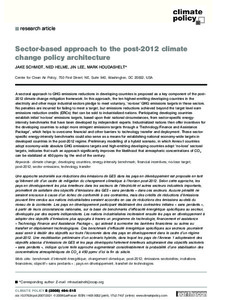Sector-based approach to the post-2012 climate change policy architecture

Schmidt, Jake ; Helme, Ned ; Lee, Jin ; Houdashelt, Mark
2008
8
5
494-515
benchmarking ; climate change ; economic aid ; energy economics ; gas emission ; technology transfer
Environment
English
Bibliogr.
"A sectoral approach to GHG emissions reductions in developing countries is proposed as a key component of the post-2012 climate change mitigation framework. In this approach, the ten highest-emitting developing countries in the electricity and other major industrial sectors pledge to meet voluntary, ‘no-lose' GHG emissions targets in these sectors. No penalties are incurred for failing to meet a target, but emissions reductions achieved beyond the target level earn emissions reduction credits (ERCs) that can be sold to industrialized nations. Participating developing countries establish initial ‘no-lose' emissions targets, based upon their national circumstances, from sector-specific energyintensity benchmarks that have been developed by independent experts. Industrialized nations then offer incentives for the developing countries to adopt more stringent emissions targets through a ‘Technology Finance and Assistance Package', which helps to overcome financial and other barriers to technology transfer and deployment. These sectorspecific energy-intensity benchmarks could also serve as a means for establishing national economy-wide targets in developed countries in the post-2012 regime. Preliminary modelling of a hybrid scenario, in which Annex I countries adopt economy-wide absolute GHG emissions targets and high-emitting developing countries adopt ‘no-lose' sectoral targets, indicates that such an approach significantly improves the likelihood that atmospheric concentrations of CO2 can be stabilized at 450 ppmv by the end of the century. "
Digital
The ETUI is co-funded by the European Union. Views and opinions expressed are however those of the author(s) only and do not necessarily reflect those of the European Union or the ETUI.